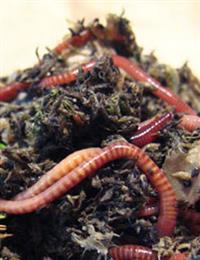Basics of Vermicomposting
Basics of Vermicomposting Product details
 Product by:
Product by:The Organic Rainbow
One of the things we encourage every amateur gardener to try doing here at Organic Rainbow is to start their very own Vermicomposting.
Vermicomposting is a process by which worms are used to con-vert household vegetable waste into nutrient-rich Compost.
The most efficient worms to use are Eisenia Foetida, com-monly known as red wiggler worms.
Critical to the success of a Worm Farm are a few simple sup-plies: a plastic bin with a cover, shredded leaves or newspapers to provide bedding, and a supply of food to facilitate reproduction.
A proper worm diet would include: Lettuce, tomato, cucumber, celery, carrots, radish, beets, greens, egg shells (crushed), coffee grounds, squash, pumpkins, pea pods, potato peels, pep-pers, eggplants, cabbage, apple peels and cores and avocado husks.
Of course, there are certain foods that you should not give to worms. Examples of foods to avoid giving to worms are: Bones, meat scraps, citrus, dairy, salty or salted food, plastics or non-biodegradable materials, kitty litter, animal waste, vinegar, or banana peels..
Under ideal conditions a mature worm produces a cocoon every 7-10 days with newborn worms maturing and beginning to reproduce after 90 days. Worm babies are translucent and appear light gray in color. Worms have five hearts and have both genders of reproductive organs and also mate with others.
Please use the Contact form on the right for Basics of Vermicomposting information and ordering.
Your message will be sent to The Organic Rainbow only. Privacy & Anti Spam protected.
-
The Organic Rainbow Contact Details »
267 Rantoul St, Beverly
Beverly, MA 1915, T: (978) 927-4600
theorganicrainbow.com/
Please let The Organic Rainbow know you found them on Green Directory
Recommended
Find Green Businesses, Eco Products and Sustainable Services
Or

